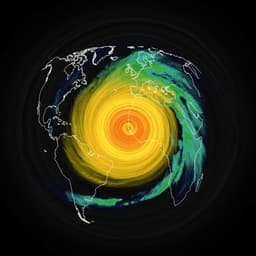Introduction
Atlantic hurricane activity is significantly influenced by climate modes like El Niño-Southern Oscillation (ENSO) and the Atlantic Meridional Mode (AMM). However, these modes are strongest during boreal winter/spring, weakening during the hurricane season (June-November). The dominant mode during the hurricane season is Atlantic Niño/Niña, characterized by warm/cold sea surface temperature (SST) anomalies in the eastern equatorial Atlantic. The relationship between Atlantic Niño/Niña and hurricane activity, however, remains understudied. This research uses observational data to explore this connection, hypothesizing that Atlantic Niño, by intensifying the Atlantic Intertropical Convergence Zone (ITCZ) rainband, boosts African Easterly Wave (AEW) activity and low-level cyclonic vorticity in the eastern North Atlantic. This, in turn, increases the probability of powerful hurricane development near the Cape Verde islands, thereby raising the risk of major hurricanes impacting the Caribbean and the U.S. Understanding this relationship is crucial for improving seasonal hurricane forecasts, especially during periods when ENSO and AMM are in neutral phases. Current seasonal outlooks rely on established relationships between oceanic and atmospheric states, such as the link between La Niña and increased Atlantic hurricane activity (due to decreased atmospheric stability and vertical wind shear). Conversely, El Niño and negative AMM typically suppress hurricane activity. West African summer monsoon intensity is also a key factor, as it fuels AEWs, crucial for hurricane genesis. However, existing forecasting models often lack the accuracy needed, as demonstrated by highly active hurricane seasons like 2003 and 2008, which occurred despite neutral ENSO and AMM conditions but coincided with Atlantic Niño events. This study aims to refine our understanding of hurricane prediction by focusing on the previously under-examined role of Atlantic Niño/Niña.
Literature Review
Existing literature establishes strong correlations between established climate modes and Atlantic hurricane activity. La Niña, characterized by cold equatorial Pacific SSTAs, often leads to increased hurricane activity via a rapid tropical teleconnection that reduces atmospheric stability and wind shear. Conversely, El Niño and the negative phase of the Atlantic Meridional Mode (AMM) suppress hurricane activity. The West African summer monsoon, impacting AEW activity, also influences Atlantic hurricane genesis. While these are established predictors, there is still significant uncertainty in forecasting hurricane seasons, especially in years where ENSO and AMM are in neutral phases. Previous studies have demonstrated the impact of Atlantic Niño/Niña on the ITCZ rainband and West African rainfall. This study builds on this work by hypothesizing that Atlantic Niño/Niña modulates hurricane activity through its influence on atmospheric convection and AEW activity.
Methodology
This study employed a composite analysis of 74 years (1948–2021) of observational and reanalysis data to investigate the links between Atlantic Niño/Niña and Atlantic tropical cyclone (TC) activity. The International Best Track Archive for Climate Stewardship (IBTRACS) provided TC genesis and track density data. Atmospheric circulation fields came from the NCEP-NCAR Reanalysis 1, precipitation data from NOAA's Gridded Precipitation Reconstruction dataset, and SST data from HadISST1. The analysis focused on the Atlantic hurricane season (June-November). Data were linearly detrended to minimize the influence of anthropogenic climate change. Atlantic Niño and Niña events were identified based on SST anomalies in the ATL3 region (3°S–3°N, 20°W–0°), exceeding one standard deviation. Similarly, El Niño and La Niña events were identified based on SST anomalies in the NIÑO3.4 region (5°S–5°N, 170°E–120°W). AMM phases were identified using the normalized AMM index. To isolate the impact of Atlantic Niño/Niña from ENSO, partial regressions of TC genesis and track density onto ATL3 and NIÑO3.4 indices were performed. Eddy kinetic energy (EKE) at 700 hPa, calculated using a wavenumber-frequency filter, served as a measure of AEW activity. Spatial patterns of TC genesis and track density were analyzed for Atlantic Niño and Niña years. Partial regressions were also used to analyze the impact of Atlantic Niño/Niña and ENSO on atmospheric TC environments, including AEWs, precipitation, low-level relative vorticity, and vertical wind shear. The study also investigated the relationship between Atlantic Niño/Niña and the genesis of major hurricanes (category 3-5), using correlations between observed and reconstructed major hurricane genesis based on the NIÑO3.4, ATL3, and both indices. Statistical significance was determined using a two-tailed Student's t-test.
Key Findings
The composite analysis revealed that during Atlantic Niño, TC genesis increases in the eastern tropical North Atlantic (east of 40°W) and the Caribbean, while it decreases in the western North Atlantic. This increase elevates TC track density, increasing the likelihood of landfall in the Caribbean and Florida. Conversely, during Atlantic Niña, TC genesis decreases over the Gulf of Mexico, Caribbean Sea, and tropical North Atlantic. Partial regression analysis, performed to isolate the effects of Atlantic Niño/Niña from ENSO, confirmed the increase in TC genesis in the eastern tropical North Atlantic during Atlantic Niño and an increase in the southern Gulf of Mexico and Caribbean Sea during La Niña. During Atlantic Niño, the ITCZ rainband strengthens, enhancing sub-Sahel West African rainfall, reinforcing AEW activity, and producing low-level westerly wind anomalies. This strengthens the West African westerly jet and positive low-level relative vorticity in the eastern tropical North Atlantic, reducing vertical wind shear and fostering TC formation near the Cape Verde islands. During La Niña, increased atmospheric convection occurs west of 30°W, with AEW activity enhanced near the West African coast but suppressed further offshore. The number of major hurricanes generated in the tropical North Atlantic is significantly higher during Atlantic Niño years (2.16 ± 0.56 per year) and lower during Atlantic Niña years (0.92 ± 0.51 per year), a difference significant at the 95% confidence level. This relationship is stronger in the post-satellite era. The ATL3 index (representing Atlantic Niño) showed better skill in reproducing major hurricane genesis over the eastern tropical North Atlantic compared to the NIÑO3.4 index (representing ENSO). Using both ATL3 and NIÑO3.4 provided the best representation of major hurricane genesis across the North Atlantic.
Discussion
This research demonstrates that Atlantic Niño/Niña significantly influences the formation of TCs, especially near the Cape Verde islands. Atlantic Niño creates atmospheric conditions favorable for hurricane formation in the deep tropics, impacting major hurricane frequency. This contrasts with ENSO's influence, which is more pronounced in the southern Gulf of Mexico, Caribbean Sea, and central tropical North Atlantic. While Atlantic Niño/Niña significantly impacts Cape Verde hurricane genesis, overall seasonal Atlantic TC activity is still largely determined by ENSO and AMM. Atlantic Niño/Niña's influence is most evident when it's out of phase with ENSO or AMM. The study highlights the potential of Atlantic Niño/Niña as an additional predictor for improving seasonal hurricane outlooks, particularly during neutral ENSO and AMM phases.
Conclusion
This study reveals the significant role of Atlantic Niño/Niña in modulating Atlantic hurricane activity, particularly the formation of major hurricanes near the Cape Verde islands. This previously under-examined climate mode adds valuable predictive information, especially when ENSO and AMM conditions are neutral. Future research should explore the finer-scale dynamics of the interactions between Atlantic Niño/Niña, ENSO, and AMM to further refine hurricane prediction models and enhance forecast accuracy. Further investigation of the predictability of Atlantic Niño/Niña itself is also warranted.
Limitations
The study relies on historical data, which may not fully capture the complexities of hurricane formation. The accuracy of pre-satellite era data may affect the results, especially for major hurricanes. While the study employs partial regression to isolate the influence of Atlantic Niño/Niña, other interacting factors could still influence the results. Future studies could incorporate more advanced modeling techniques to account for these complexities.
Related Publications
Explore these studies to deepen your understanding of the subject.






